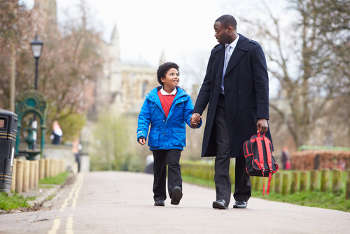People in England are making fewer trips every year but travelled slightly further last year than in 2014, according to new statistics.
The National Travel Survey: 2015, published by the Department for Transport (DfT), reveals that the average number of trips made in 2015 – 914 per person – was the lowest recorded and 13% lower than in 2002.
Trip rates have been falling steadily since 1995/97. Compared to the 1970s, the number of trips taken is broadly stable, having decreased by 4%, although the distance travelled per person has increased by 49%.
Car is the most common mode of travel, accounting for 64% of trips and 78% of the distance travelled in 2015.

Only 48% of 5-10 year olds walk to/from school
DfT officials said analysis concludes there is little evidence to confirm that car ownership levels or distance travelled per person have reached saturation. The hypothesis that car driver mileage per person has reached a peak and will now begin to fall is known as ‘peak car’.
Although walking accounts for 22% of trips, it is mainly predominant for very short distances. While 76% of all trips under one mile are walks, for all other distance bands, the car is the most frequent mode of travel.
The proportion of children who walk to/from school is 48% for 5-10 year olds and 37% for 11-16 year olds, reflecting the fact that older children travel further to school on average. For journeys under one mile, equivalent figures are 78% of 5-10 year and 87% olds of 11-16 year olds.
Charity Living Streets said the survey shows the number of children walking to primary school is at the lowest figure ever and compares to 70% in the 1970s.
Tompion Platt, the charity’s head of policy and communications, said: ‘With a looming health crisis among children, everyday walking to school is a major part of the solution. It’s free and accessible and we know from the schools we work with that the recent decline in walking rates can be reversed. We urge the Government, schools and parents to join us in enabling more pupils to walk to school and give children the best start in life.’
The survey also shows that the average distance cycled per person per year has increased by 16% since 1995/97, although cycling still accounts for only 2% of trips.
On average, women make more trips than men, but men travel 20% further, which is mostly due to more commuting mileage.
Residents of rural areas travel around 44% further than urban residents and almost twice as much as London residents.
Register now for full access
Register just once to get unrestricted, real-time coverage of the issues and challenges facing UK transport and highways engineers.
Full website content includes the latest news, exclusive commentary from leading industry figures and detailed topical analysis of the highways, transportation, environment and place-shaping sectors.
Use the link below to register your details for full, free access.
Already a registered? Login